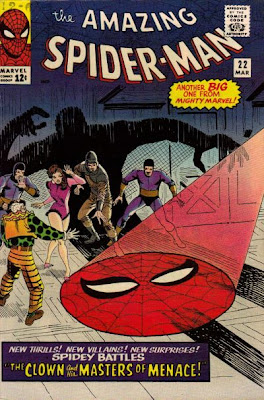 (Cover from August 1965.)
(Cover from August 1965.)"Bring Back My Goblin To Me!"
Scripted by Stan Lee.
Plotted, drawn and inked by Steve Ditko.
Lettered by Artie Simek.
And the prize for the worst story title of all time goes to...
Meanwhile, it's another issue gone, the Green Goblin's still being a bit of a no-mark and the Crime-Master's still just a man in a hat.
You can't get away from the fact the strip's repeating itself here, with the Goblin's attempt to take over the city's mobs having been done before, the Crime-Master being a slightly more interesting rehash of the Big Man, and Spider-Man's battle with just about every gangster in town being a rerun of Amazing Spider-Man #10. Oh well, at least the Enforcers didn't show up. They finally (I hope) seem to have been consigned to the dustbin of history.
In fact, the main point of interest in this tale, and its one new development, is the revelation that the Daily Bugle's only known reporter Fred Foswell - who we've all been suspecting of being the Crime-Master and then the Goblin - is in fact Patch the stool pigeon. I never really understood the Patch character, as it seemed like everyone in New York knew he was a stool pigeon, making you wonder why anyone ever told him anything.
I can't think of anything much more to say about this issue, other than that it's nicely drawn but what I've been reading lately isn't really doing anything to dissuade me from the notion that the second half of Ditko's run on the strip wasn't as good as the first and that the title didn't regain its momentum until early in John Romita's run.

































.JPG)














